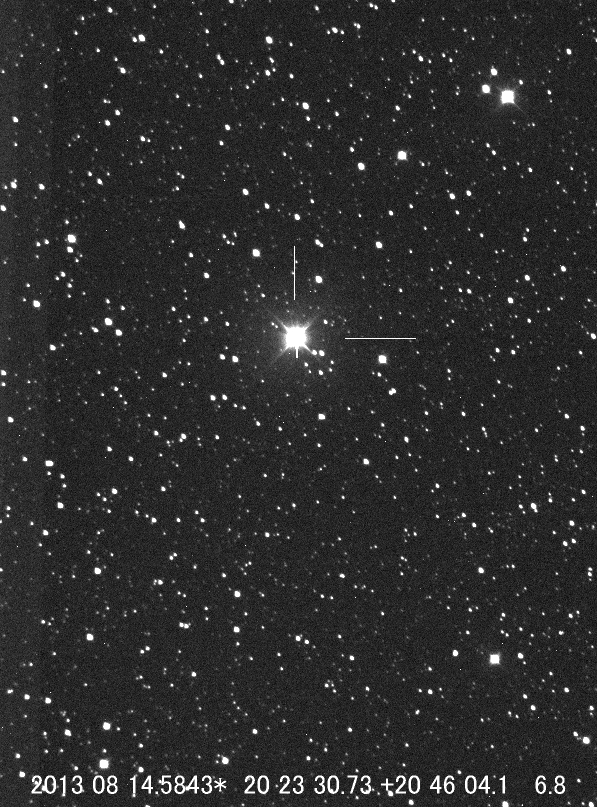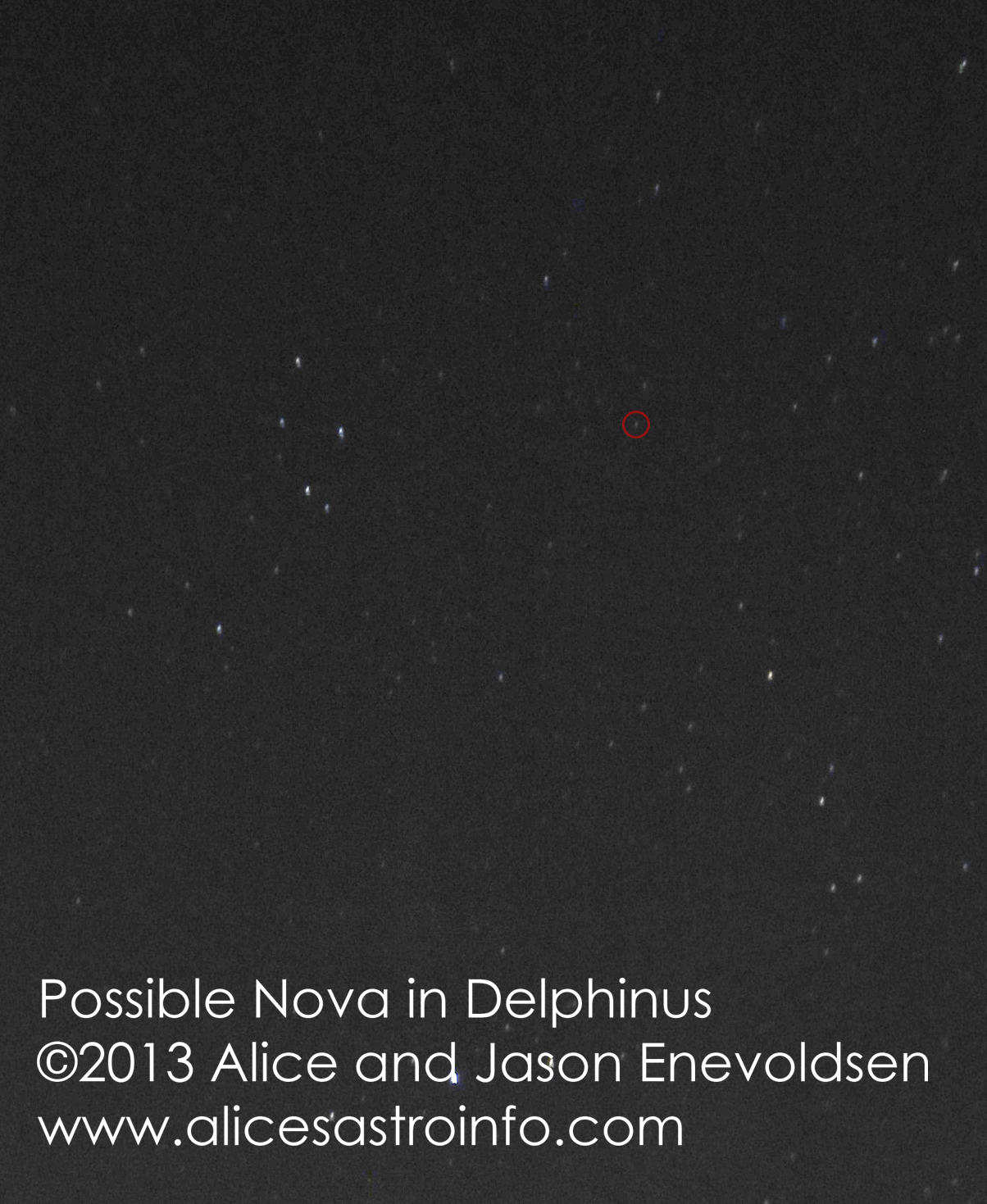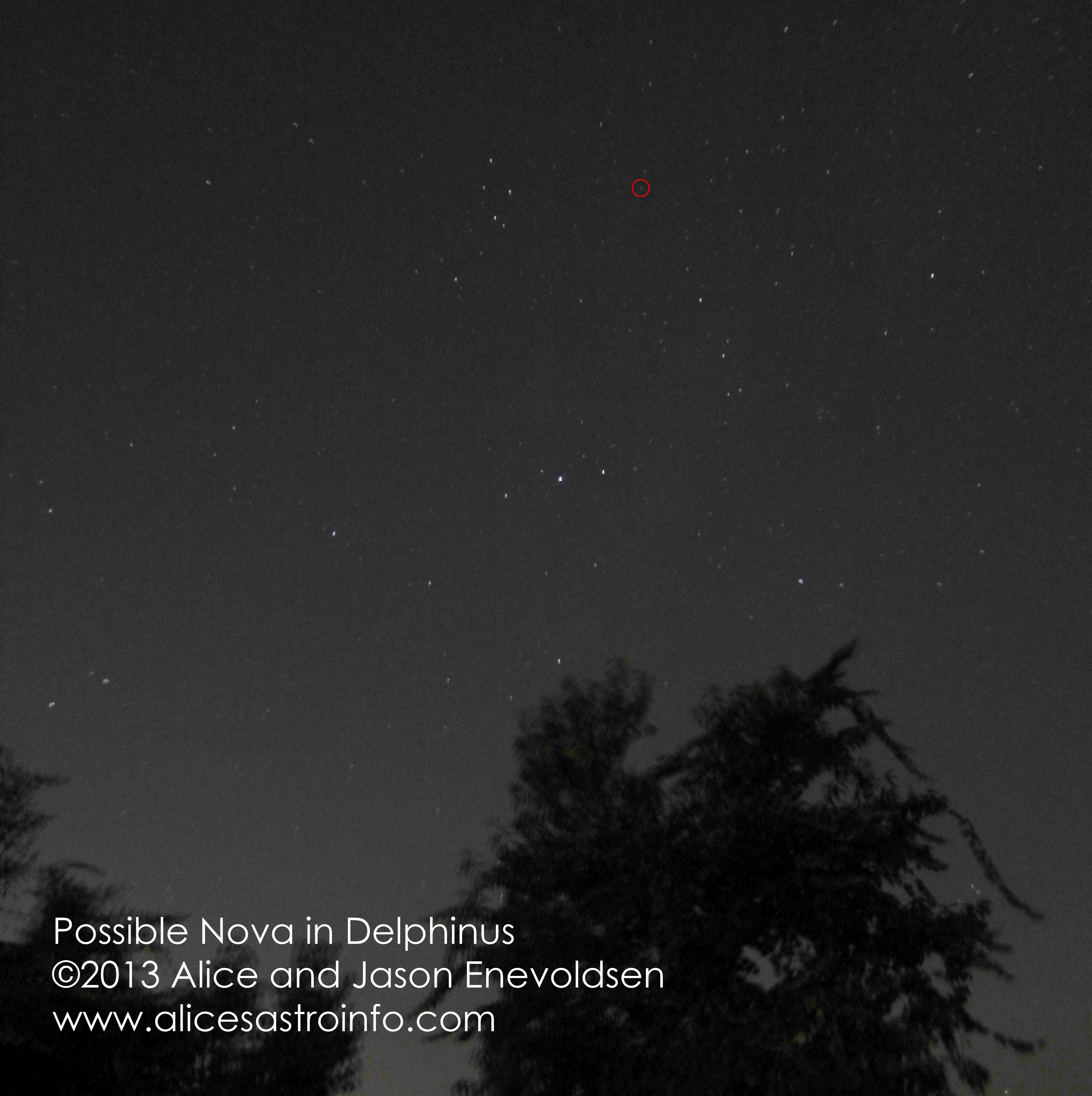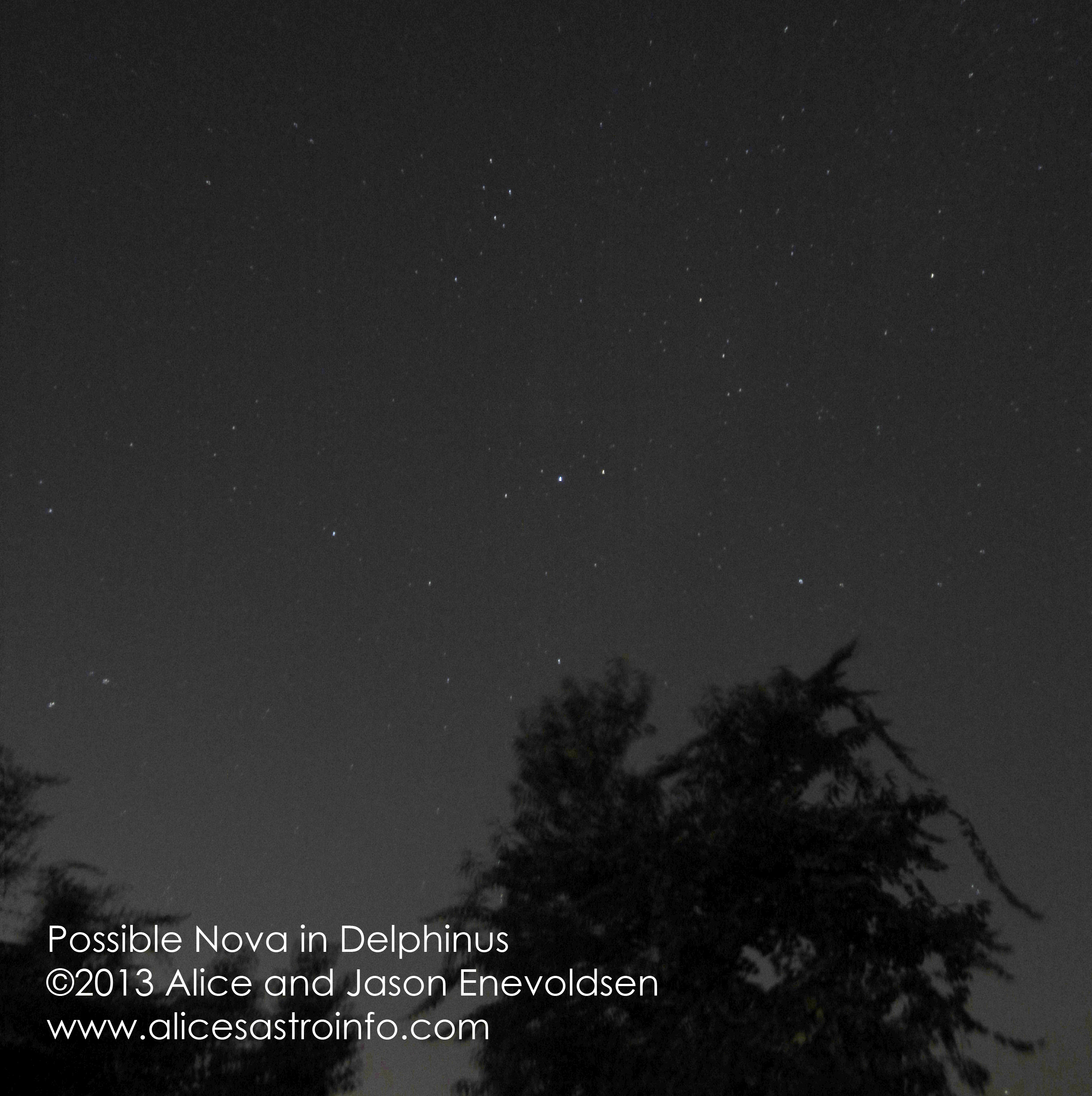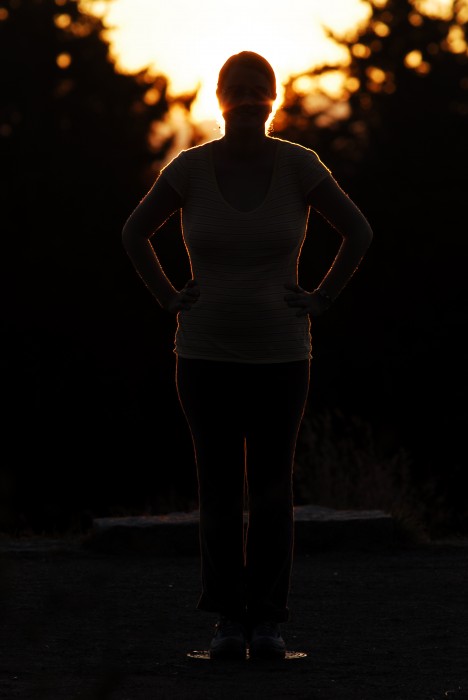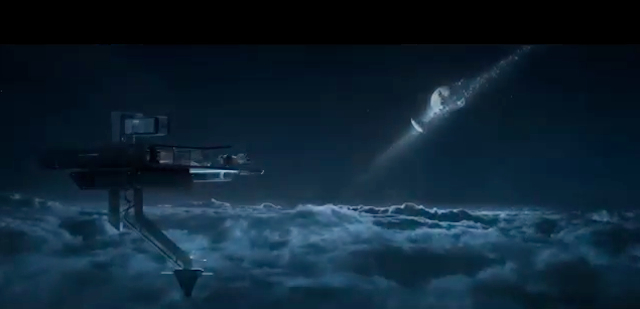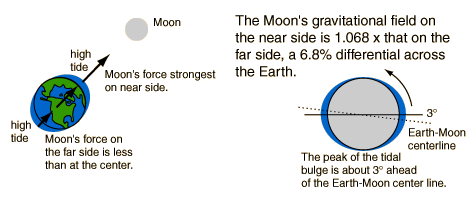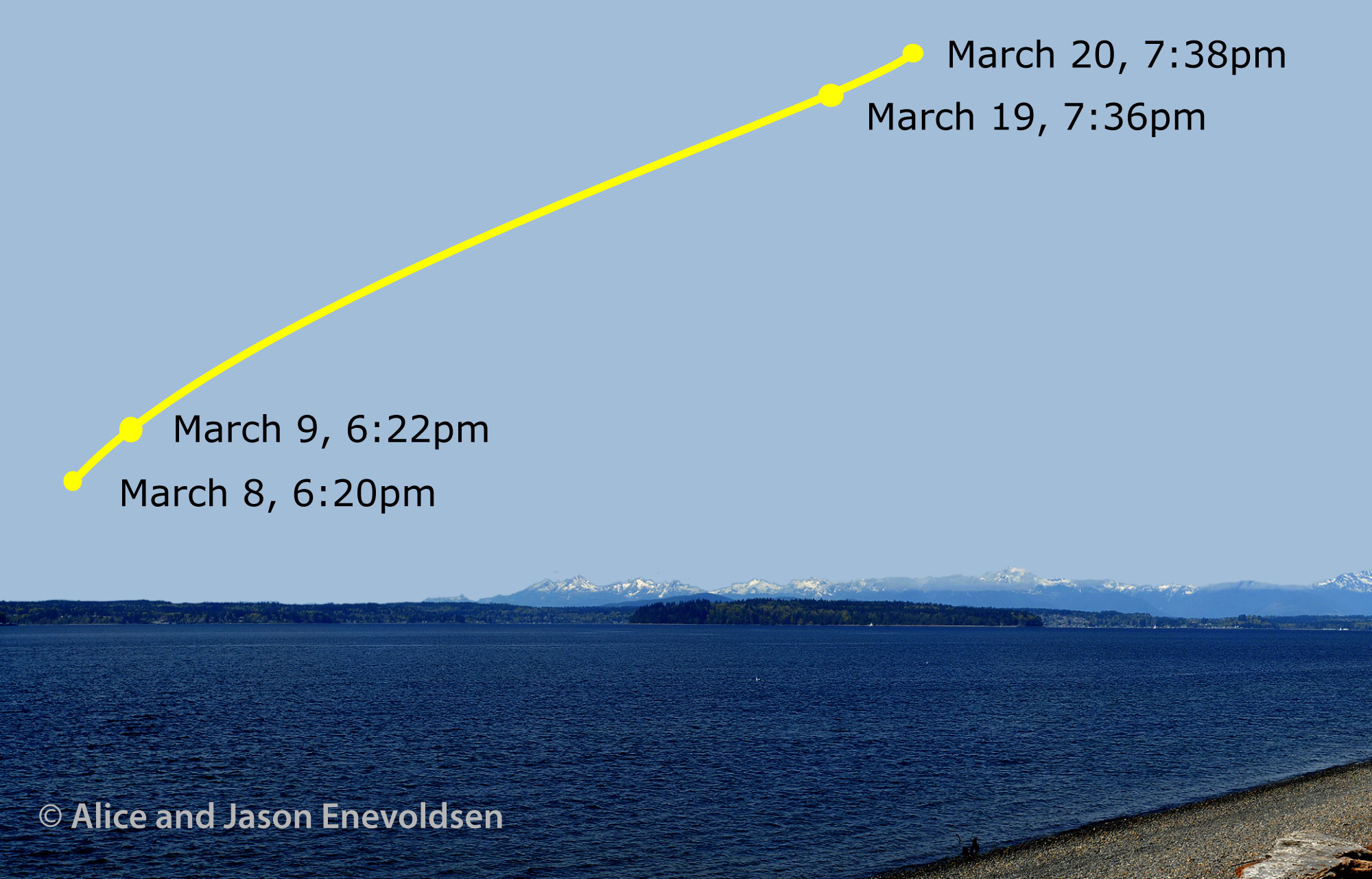Archive for the ‘AstroInfo Article’ Category
 Comet ISON from Seattle, after Perihelion (November 28)
Comet ISON from Seattle, after Perihelion (November 28)
Latest Updates on Comet ISON
by Alan MacRobert
“Only a dim “ghost of ISON” survived the comet’s November 28th passage around the Sun. The comet’s head dwindled away as it raced through the Sun’s greatest heat, but a headless streak emerged into spacecraft view out from the other side of the encounter. It’s traveling along the comet’s originally prescribed track but fading steadily, with no sign of cometary activity. Very little or nothing is likely to become visible from Earth.”From: http://www.skyandtelescope.com/community/skyblog/observingblog/193909261.html which is a good, trustworthy general observing resource
Me again:
So as we come out of the blind period today and tomorrow, we are not going to be able to observe Comet ISON from Seattle unless something unexpected and unprecedented happens. Comets are notably unpredictable, but that unpredictability peaks as they pass the Sun, and then they are usually much more normal and not so erratic in their brightness and tail-length after their closest approach.
So, the “Comet of the Century” is relegated to being “the most-anticipated comet of the decade.” Not to worry, we still have two other visible comets in our night sky: Lovejoy and Encke. There’s also Comet LINEAR, but that one is also for experienced viewers.
Advanced viewers can use the finding charts at Waiting For ISON to find Comet ISON with telescopes: http://waitingforison.wordpress.com/november-2013/Text Block 1
![]()
~ A l i c e !
 Watch the MAVEN Launch With Me: Monday at 10am Pacific
Watch the MAVEN Launch With Me: Monday at 10am Pacific
Hey everyone, I’ll be live-Google-Hangouting from the MAVEN launch (next mission to Mars) in Florida on Monday morning (November 18th. The launch is at about 10:20 Pacific Time, so tune in around 10am.). That’s right, you get me as an on-location reporter for this launch for the first time ever … I’ve never been to a real in-person launch before. I’ll be watching from the Causeway.
I’ll be co-hosting with Shannon Hall and Sarah Culp, who will be Hangouting from Pacific Science Center. Turn on NASA TV in one browser, and join our Hangout in another. Can’t wait to see you! I’ll be posting links here as I get them, and if all else fails check in on my Twitter and Pacific Science Center’s Twitter to get the full scoop that morning!
You can also join Shannon and Sarah in person at Pacific Science Center, details to follow later this afternoon.
Edit to add: You can listen to my interview on KOMO about the MAVEN launch if you missed this hangout or the interview on the actual day of launch.
![]()
~ A l i c e !
 Comet ISON from Seattle
Comet ISON from Seattle
Ready to view Comet ISON? Here’s useful rise, set, and estimated magnitude for viewing from Seattle between now and March. I’ve color-coded it according to east of viewing. Magnitude (brightness) will change as we get more observations of ISON and see how it is responding to the Sun.
This is a useful table if you know what visual magnitude is. If you don’t, just go out too look for it on days that are highlighted yellow. Also, check out the “Special circumstances” for great viewing opportunities.
In this, I’m assuming a generic pair of binoculars can see down to about magnitude 10, and have a 5-7 degree field of view. Your binoculars may be different, but if you pull out a random pair that’s in your closet these assumptions probably aren’t that far off.
| Local Date | Sun | Sun | C/2012 S1 (ISON) | C/2012 S1 (ISON) | C/2012 S1 (ISON) | How should you see it? | Special circumstances |
| Rise Time | Set Time | Rise Time | Set Time | Visual Magnitude | |||
| 9/4/2013 | 6:32 | 19:44 | 3:16 | 18:48 | 11.9 | Telescope | |
| 9/4/2013 | 6:32 | 19:44 | 3:16 | 18:48 | 11.9 | Telescope | |
| 9/5/2013 | 6:34 | 19:42 | 3:14 | 18:45 | 11.8 | Telescope | |
| 9/6/2013 | 6:35 | 19:40 | 3:12 | 18:42 | 11.8 | Telescope | |
| 9/7/2013 | 6:36 | 19:38 | 3:10 | 18:39 | 11.7 | Telescope | |
| 9/8/2013 | 6:38 | 19:36 | 3:09 | 18:36 | 11.7 | Telescope | |
| 9/9/2013 | 6:39 | 19:34 | 3:07 | 18:33 | 11.6 | Telescope | |
| 9/10/2013 | 6:40 | 19:31 | 3:06 | 18:29 | 11.6 | Telescope | |
| 9/11/2013 | 6:42 | 19:29 | 3:04 | 18:26 | 11.5 | Telescope | |
| 9/12/2013 | 6:43 | 19:27 | 3:03 | 18:23 | 11.5 | Telescope | |
| 9/13/2013 | 6:44 | 19:25 | 3:01 | 18:20 | 11.4 | Telescope | |
| 9/14/2013 | 6:46 | 19:23 | 3:00 | 18:17 | 11.4 | Telescope | |
| 9/15/2013 | 6:47 | 19:21 | 2:58 | 18:14 | 11.3 | Telescope | |
| 9/16/2013 | 6:48 | 19:19 | 2:57 | 18:11 | 11.3 | Telescope | |
| 9/17/2013 | 6:50 | 19:17 | 2:55 | 18:08 | 11.2 | Telescope | |
| 9/18/2013 | 6:51 | 19:15 | 2:54 | 18:05 | 11.2 | Telescope | |
| 9/19/2013 | 6:52 | 19:13 | 2:53 | 18:02 | 11.1 | Telescope | |
| 9/20/2013 | 6:54 | 19:11 | 2:51 | 17:59 | 11 | Telescope | |
| 9/21/2013 | 6:55 | 19:09 | 2:50 | 17:56 | 11 | Telescope | |
| 9/22/2013 | 6:56 | 19:07 | 2:49 | 17:53 | 10.9 | Telescope | |
| 9/23/2013 | 6:58 | 19:05 | 2:48 | 17:50 | 10.9 | Telescope | About 2 degrees from Mars, about 1 degree from the asteroid Eros (take a photo with your telescope) |
| 9/24/2013 | 6:59 | 19:03 | 2:47 | 17:48 | 10.8 | Telescope | Conjunction: about 2 degrees from Mars, about 1 degree from the asteroid Eros (take a photo with your telescope) |
| 9/25/2013 | 7:00 | 19:01 | 2:46 | 17:45 | 10.7 | Telescope | About 2 degrees from Mars, about 1 degree from the asteroid Eros (take a photo with your telescope) |
| 9/26/2013 | 7:02 | 18:59 | 2:45 | 17:42 | 10.7 | Telescope | |
| 9/27/2013 | 7:03 | 18:57 | 2:44 | 17:39 | 10.6 | Telescope | |
| 9/28/2013 | 7:05 | 18:55 | 2:43 | 17:36 | 10.5 | Telescope | |
| 9/29/2013 | 7:06 | 18:53 | 2:42 | 17:33 | 10.5 | Telescope | |
| 9/30/2013 | 7:07 | 18:51 | 2:41 | 17:30 | 10.4 | Telescope | |
| 10/1/2013 | 7:09 | 18:49 | 2:40 | 17:27 | 10.3 | Telescope | |
| 10/2/2013 | 7:10 | 18:47 | 2:40 | 17:24 | 10.3 | Telescope | |
| 10/3/2013 | 7:11 | 18:45 | 2:39 | 17:22 | 10.2 | Telescope | |
| 10/4/2013 | 7:13 | 18:43 | 2:38 | 17:19 | 10.1 | Telescope | |
| 10/5/2013 | 7:14 | 18:41 | 2:38 | 17:16 | 10 | Telescope | |
| 10/6/2013 | 7:16 | 18:39 | 2:37 | 17:13 | 10 | Telescope | |
| 10/7/2013 | 7:17 | 18:37 | 2:37 | 17:10 | 9.9 | Good binoculars | |
| 10/8/2013 | 7:18 | 18:35 | 2:37 | 17:08 | 9.8 | Good binoculars | |
| 10/9/2013 | 7:20 | 18:33 | 2:37 | 17:05 | 9.7 | Good binoculars | |
| 10/10/2013 | 7:21 | 18:31 | 2:37 | 17:02 | 9.6 | Good binoculars | |
| 10/11/2013 | 7:23 | 18:29 | 2:37 | 16:59 | 9.6 | Good binoculars | |
| 10/12/2013 | 7:24 | 18:27 | 2:37 | 16:57 | 9.5 | Good binoculars | |
| 10/13/2013 | 7:26 | 18:25 | 2:37 | 16:54 | 9.4 | Good binoculars | About 1 degree from Mars, about 2 degrees from Regulus (all three fit within a binocular’s field of view) |
| 10/14/2013 | 7:27 | 18:23 | 2:37 | 16:51 | 9.3 | Good binoculars | About 1 degree from Mars, about 2 degrees from Regulus (all three fit within a binocular’s field of view) |
| 10/15/2013 | 7:28 | 18:21 | 2:38 | 16:49 | 9.2 | Good binoculars | Conjunction: about 1 degree from Mars, about 2 degrees from Regulus (all three fit within a binocular’s field of view) |
| 10/16/2013 | 7:30 | 18:19 | 2:38 | 16:46 | 9.1 | Good binoculars | About 1 degree from Mars, about 2 degrees from Regulus (all three fit within a binocular’s field of view) |
| 10/17/2013 | 7:31 | 18:18 | 2:39 | 16:44 | 9 | Binoculars | About 1 degree from Mars, about 2 degrees from Regulus (all three fit within a binocular’s field of view) |
| 10/18/2013 | 7:33 | 18:16 | 2:40 | 16:41 | 8.9 | Binoculars | |
| 10/19/2013 | 7:34 | 18:14 | 2:41 | 16:39 | 8.8 | Binoculars | |
| 10/20/2013 | 7:36 | 18:12 | 2:42 | 16:36 | 8.7 | Binoculars | |
| 10/21/2013 | 7:37 | 18:10 | 2:43 | 16:34 | 8.6 | Binoculars | |
| 10/22/2013 | 7:39 | 18:09 | 2:44 | 16:31 | 8.5 | Binoculars | |
| 10/23/2013 | 7:40 | 18:07 | 2:46 | 16:29 | 8.4 | Binoculars | |
| 10/24/2013 | 7:42 | 18:05 | 2:48 | 16:27 | 8.3 | Binoculars | About 2 degrees from M95, M96, about 3 degrees from M105 (Beautiful photo opportunity, all four fit in a binocular’s field of view) |
| 10/25/2013 | 7:43 | 18:03 | 2:50 | 16:24 | 8.2 | Binoculars | About 2 degrees from M95, M96, about 3 degrees from M105 (Beautiful photo opportunity, all four fit in a binocular’s field of view) |
| 10/26/2013 | 7:45 | 18:02 | 2:52 | 16:22 | 8.1 | Binoculars | |
| 10/27/2013 | 6:46 | 17:00 | 1:55 | 15:20 | 7.9 | Binoculars | Earliest morning rise time |
| 10/28/2013 | 6:48 | 16:58 | 1:58 | 15:18 | 7.8 | Binoculars | |
| 10/29/2013 | 6:49 | 16:57 | 2:01 | 15:16 | 7.7 | Binoculars | |
| 10/30/2013 | 6:51 | 16:55 | 2:04 | 15:14 | 7.6 | Binoculars | |
| 10/31/2013 | 6:52 | 16:54 | 2:08 | 15:12 | 7.4 | Binoculars | |
| 11/1/2013 | 6:54 | 16:52 | 2:12 | 15:10 | 7.3 | Binoculars | |
| 11/2/2013 | 6:55 | 16:50 | 2:16 | 15:09 | 7.2 | Binoculars | |
| 11/3/2013 | 6:57 | 16:49 | 2:21 | 15:07 | 7 | Binoculars | |
| 11/4/2013 | 6:58 | 16:47 | 2:26 | 15:06 | 6.9 | Binoculars | |
| 11/5/2013 | 7:00 | 16:46 | 2:32 | 15:04 | 6.7 | Binoculars | |
| 11/6/2013 | 7:01 | 16:45 | 2:38 | 15:03 | 6.6 | Binoculars | |
| 11/7/2013 | 7:03 | 16:43 | 2:44 | 15:02 | 6.4 | Binoculars | About 4 degrees from asteroid Vesta (both fit in binocular field of view) |
| 11/8/2013 | 7:04 | 16:42 | 2:51 | 15:01 | 6.2 | Binoculars | |
| 11/9/2013 | 7:06 | 16:41 | 2:59 | 15:00 | 6.1 | Binoculars | |
| 11/10/2013 | 7:07 | 16:39 | 3:07 | 14:59 | 5.9 | Eyes in dark skies | |
| 11/11/2013 | 7:09 | 16:38 | 3:16 | 14:59 | 5.7 | Eyes in dark skies | |
| 11/12/2013 | 7:10 | 16:37 | 3:26 | 14:59 | 5.5 | Eyes in dark skies | |
| 11/13/2013 | 7:12 | 16:36 | 3:36 | 14:59 | 5.3 | Eyes in dark skies | |
| 11/14/2013 | 7:13 | 16:34 | 3:47 | 14:59 | 5.1 | Eyes in dark skies | |
| 11/15/2013 | 7:15 | 16:33 | 3:59 | 14:59 | 4.9 | Eyes in Seattle | |
| 11/16/2013 | 7:16 | 16:32 | 4:12 | 15:00 | 4.7 | Eyes in Seattle | |
| 11/17/2013 | 7:18 | 16:31 | 4:25 | 15:01 | 4.5 | Eyes in Seattle | About 1 degree from Spica — makes it easy to find ISON |
| 11/18/2013 | 7:19 | 16:30 | 4:39 | 15:03 | 4.2 | Eyes in Seattle | About 1 degree from Spica — makes it easy to find ISON |
| 11/19/2013 | 7:20 | 16:29 | 4:54 | 15:05 | 3.9 | Eyes in Seattle | |
| 11/20/2013 | 7:22 | 16:28 | 5:10 | 15:08 | 3.6 | Eyes in Seattle | |
| 11/21/2013 | 7:23 | 16:27 | 5:26 | 15:11 | 3.3 | Eyes in Seattle | |
| 11/22/2013 | 7:25 | 16:26 | 5:43 | 15:15 | 2.9 | Eyes in Seattle | |
| 11/23/2013 | 7:26 | 16:26 | 6:01 | 15:19 | 2.5 | Eyes in Seattle | |
| 11/24/2013 | 7:27 | 16:25 | 6:19 | 15:25 | 2 | Eyes in Seattle | About 2 degrees from Comet Encke (estimated magnitude 5, at the edge of visibility in Seattle with just your eyes) — Great photo opportunity |
| 11/25/2013 | 7:29 | 16:24 | 6:37 | 15:31 | 1.3 | Eyes in Seattle | |
| 11/26/2013 | 7:30 | 16:23 | 6:56 | 15:40 | 0.2 | Only up during daylight | |
| 11/27/2013 | 7:32 | 16:23 | 7:16 | 15:53 | -1.8 | Only up during daylight | |
| 11/28/2013 | 7:33 | 16:22 | 7:38 | 16:33 | -4.8 | Only up during daylight | Perihelion (closest approach to the Sun) |
| 11/29/2013 | 7:34 | 16:22 | 7:14 | 16:45 | -0.7 | Only up during daylight | |
| 11/30/2013 | 7:35 | 16:21 | 6:56 | 16:50 | 0.7 | Only up during daylight | |
| 12/1/2013 | 7:37 | 16:21 | 6:40 | 16:54 | 1.5 | Eyes in Seattle | |
| 12/2/2013 | 7:38 | 16:20 | 6:25 | 16:57 | 2 | Eyes in Seattle | Begins to be visible briefly after sunset/twilight as well as in the morning |
| 12/3/2013 | 7:39 | 16:20 | 6:12 | 17:01 | 2.5 | Eyes in Seattle | |
| 12/4/2013 | 7:40 | 16:20 | 5:58 | 17:04 | 2.8 | Eyes in Seattle | |
| 12/5/2013 | 7:41 | 16:19 | 5:45 | 17:07 | 3.1 | Eyes in Seattle | |
| 12/6/2013 | 7:42 | 16:19 | 5:33 | 17:11 | 3.3 | Eyes in Seattle | |
| 12/7/2013 | 7:43 | 16:19 | 5:20 | 17:15 | 3.5 | Eyes in Seattle | |
| 12/8/2013 | 7:44 | 16:19 | 5:07 | 17:19 | 3.7 | Eyes in Seattle | |
| 12/9/2013 | 7:45 | 16:19 | 4:54 | 17:24 | 3.8 | Eyes in Seattle | |
| 12/10/2013 | 7:46 | 16:19 | 4:41 | 17:29 | 4 | Eyes in Seattle | Visible in the evening as well as the morning |
| 12/11/2013 | 7:47 | 16:19 | 4:28 | 17:35 | 4.1 | Eyes in Seattle | |
| 12/12/2013 | 7:48 | 16:19 | 4:14 | 17:41 | 4.2 | Eyes in Seattle | |
| 12/13/2013 | 7:49 | 16:19 | 3:59 | 17:48 | 4.3 | Eyes in Seattle | |
| 12/14/2013 | 7:50 | 16:19 | 3:44 | 17:57 | 4.3 | Eyes in Seattle | |
| 12/15/2013 | 7:51 | 16:19 | 3:28 | 18:06 | 4.4 | Eyes in Seattle | |
| 12/16/2013 | 7:51 | 16:19 | 3:11 | 18:18 | 4.5 | Eyes in Seattle | |
| 12/17/2013 | 7:52 | 16:20 | 2:53 | 18:31 | 4.6 | Eyes in Seattle | |
| 12/18/2013 | 7:53 | 16:20 | 2:33 | 18:46 | 4.6 | Eyes in Seattle | |
| 12/19/2013 | 7:53 | 16:20 | 2:10 | 19:05 | 4.7 | Eyes in Seattle | |
| 12/20/2013 | 7:54 | 16:21 | 1:45 | 19:28 | 4.8 | Eyes in Seattle | |
| 12/21/2013 | 7:54 | 16:21 | 1:15 | 19:59 | 4.8 | Eyes in Seattle | |
| 12/22/2013 | 7:55 | 16:22 | 0:37 | 20:48 | 4.9 | Eyes in Seattle | About 5 degrees from M31 (photo opportunity) |
| 12/23/2013 | 7:55 | 16:22 | NoRis | NoSet | 5 | Eyes in Seattle | Becomes circumpolar (visible all night, also up all day though not visible then) |
| 12/24/2013 | 7:56 | 16:23 | CirPl | CirPl | 5 | Eyes in Seattle | |
| 12/25/2013 | 7:56 | 16:24 | CirPl | CirPl | 5.1 | Eyes in dark skies | |
| 12/26/2013 | 7:56 | 16:24 | CirPl | CirPl | 5.2 | Eyes in dark skies | |
| 12/27/2013 | 7:57 | 16:25 | CirPl | CirPl | 5.3 | Eyes in dark skies | |
| 12/28/2013 | 7:57 | 16:26 | CirPl | CirPl | 5.4 | Eyes in dark skies | |
| 12/29/2013 | 7:57 | 16:27 | CirPl | CirPl | 5.5 | Eyes in dark skies | |
| 12/30/2013 | 7:57 | 16:28 | CirPl | CirPl | 5.6 | Eyes in dark skies | |
| 12/31/2013 | 7:57 | 16:29 | CirPl | CirPl | 5.7 | Eyes in dark skies | |
| 1/1/2014 | 7:57 | 16:30 | CirPl | CirPl | 5.8 | Eyes in dark skies | |
| 1/2/2014 | 7:57 | 16:31 | CirPl | CirPl | 5.9 | Eyes in dark skies | |
| 1/3/2014 | 7:57 | 16:32 | CirPl | CirPl | 6 | Eyes in dark skies | |
| 1/4/2014 | 7:57 | 16:33 | CirPl | CirPl | 6.1 | Binoculars | |
| 1/5/2014 | 7:57 | 16:34 | CirPl | CirPl | 6.3 | Binoculars | |
| 1/6/2014 | 7:56 | 16:35 | CirPl | CirPl | 6.4 | Binoculars | About 3 degrees from Polaris (both fit in binocular field of view) |
| 1/7/2014 | 7:56 | 16:36 | CirPl | CirPl | 6.5 | Binoculars | |
| 1/8/2014 | 7:56 | 16:37 | CirPl | CirPl | 6.6 | Binoculars | |
| 1/9/2014 | 7:55 | 16:38 | CirPl | CirPl | 6.8 | Binoculars | |
| 1/10/2014 | 7:55 | 16:40 | CirPl | CirPl | 6.9 | Binoculars | |
| 1/11/2014 | 7:55 | 16:41 | CirPl | CirPl | 7 | Binoculars | |
| 1/12/2014 | 7:54 | 16:42 | CirPl | CirPl | 7.1 | Binoculars | |
| 1/13/2014 | 7:54 | 16:44 | CirPl | CirPl | 7.2 | Binoculars | |
| 1/14/2014 | 7:53 | 16:45 | CirPl | CirPl | 7.4 | Binoculars | |
| 1/15/2014 | 7:52 | 16:46 | CirPl | CirPl | 7.5 | Binoculars | |
| 1/16/2014 | 7:52 | 16:48 | CirPl | CirPl | 7.6 | Binoculars | |
| 1/17/2014 | 7:51 | 16:49 | CirPl | CirPl | 7.7 | Binoculars | |
| 1/18/2014 | 7:50 | 16:50 | CirPl | CirPl | 7.8 | Binoculars | |
| 1/19/2014 | 7:49 | 16:52 | CirPl | CirPl | 8 | Binoculars | |
| 1/20/2014 | 7:48 | 16:53 | CirPl | CirPl | 8.1 | Binoculars | |
| 1/21/2014 | 7:48 | 16:55 | CirPl | CirPl | 8.2 | Binoculars | |
| 1/22/2014 | 7:47 | 16:56 | CirPl | CirPl | 8.3 | Binoculars | |
| 1/23/2014 | 7:46 | 16:58 | CirPl | CirPl | 8.4 | Binoculars | |
| 1/24/2014 | 7:45 | 16:59 | CirPl | CirPl | 8.5 | Binoculars | |
| 1/25/2014 | 7:44 | 17:01 | CirPl | CirPl | 8.6 | Binoculars | |
| 1/26/2014 | 7:43 | 17:02 | CirPl | CirPl | 8.7 | Binoculars | |
| 1/27/2014 | 7:41 | 17:04 | CirPl | CirPl | 8.8 | Binoculars | |
| 1/28/2014 | 7:40 | 17:05 | CirPl | CirPl | 8.9 | Binoculars | |
| 1/29/2014 | 7:39 | 17:07 | CirPl | CirPl | 9 | Good binoculars | |
| 1/30/2014 | 7:38 | 17:08 | CirPl | CirPl | 9.1 | Good binoculars | |
| 1/31/2014 | 7:37 | 17:10 | CirPl | CirPl | 9.2 | Good binoculars | |
| 2/1/2014 | 7:35 | 17:12 | CirPl | CirPl | 9.2 | Good binoculars | |
| 2/2/2014 | 7:34 | 17:13 | CirPl | CirPl | 9.3 | Good binoculars | |
| 2/3/2014 | 7:33 | 17:15 | CirPl | CirPl | 9.4 | Good binoculars | |
| 2/4/2014 | 7:31 | 17:16 | CirPl | CirPl | 9.5 | Good binoculars | |
| 2/5/2014 | 7:30 | 17:18 | CirPl | CirPl | 9.6 | Good binoculars | |
| 2/6/2014 | 7:28 | 17:19 | CirPl | CirPl | 9.7 | Good binoculars | |
| 2/7/2014 | 7:27 | 17:21 | CirPl | CirPl | 9.8 | Good binoculars | |
| 2/8/2014 | 7:26 | 17:23 | CirPl | CirPl | 9.8 | Good binoculars | |
| 2/9/2014 | 7:24 | 17:24 | CirPl | CirPl | 9.9 | Good binoculars | |
| 2/10/2014 | 7:22 | 17:26 | CirPl | CirPl | 10 | Good binoculars | |
| 2/11/2014 | 7:21 | 17:27 | CirPl | CirPl | 10.1 | Telescope | |
| 2/12/2014 | 7:19 | 17:29 | CirPl | CirPl | 10.1 | Telescope | |
| 2/13/2014 | 7:18 | 17:30 | CirPl | CirPl | 10.2 | Telescope | |
| 2/14/2014 | 7:16 | 17:32 | CirPl | CirPl | 10.3 | Telescope | |
| 2/15/2014 | 7:14 | 17:34 | CirPl | CirPl | 10.3 | Telescope | |
| 2/16/2014 | 7:13 | 17:35 | CirPl | CirPl | 10.4 | Telescope | |
| 2/17/2014 | 7:11 | 17:37 | CirPl | CirPl | 10.5 | Telescope | |
| 2/18/2014 | 7:09 | 17:38 | CirPl | CirPl | 10.6 | Telescope | |
| 2/19/2014 | 7:08 | 17:40 | CirPl | CirPl | 10.6 | Telescope | |
| 2/20/2014 | 7:06 | 17:41 | CirPl | CirPl | 10.7 | Telescope | |
| 2/21/2014 | 7:04 | 17:43 | CirPl | CirPl | 10.8 | Telescope | |
| 2/22/2014 | 7:02 | 17:44 | CirPl | CirPl | 10.8 | Telescope | |
| 2/23/2014 | 7:00 | 17:46 | CirPl | CirPl | 10.9 | Telescope | |
| 2/24/2014 | 6:59 | 17:47 | CirPl | CirPl | 10.9 | Telescope | |
| 2/25/2014 | 6:57 | 17:49 | CirPl | CirPl | 11 | Telescope | |
| 2/26/2014 | 6:55 | 17:50 | CirPl | CirPl | 11.1 | Telescope | |
| 2/27/2014 | 6:53 | 17:52 | CirPl | CirPl | 11.1 | Telescope | |
| 2/28/2014 | 6:51 | 17:54 | CirPl | CirPl | 11.2 | Telescope | |
| 3/1/2014 | 6:49 | 17:55 | CirPl | CirPl | 11.3 | Telescope | |
| 3/2/2014 | 7:47 | 18:57 | CirPl | CirPl | 11.3 | Telescope | |
| 3/3/2014 | 7:46 | 18:58 | CirPl | CirPl | 11.4 | Telescope | |
| 3/4/2014 | 7:44 | 19:00 | CirPl | CirPl | 11.4 | Telescope | |
| 3/5/2014 | 7:42 | 19:01 | CirPl | CirPl | 11.5 | Telescope | |
| 3/6/2014 | 7:40 | 19:02 | CirPl | CirPl | 11.5 | Telescope | |
| 3/7/2014 | 7:38 | 19:04 | CirPl | CirPl | 11.6 | Telescope | |
| 3/8/2014 | 7:36 | 19:05 | CirPl | CirPl | 11.7 | Telescope | |
| 3/9/2014 | 7:34 | 19:07 | CirPl | CirPl | 11.7 | Telescope | |
| 3/10/2014 | 7:32 | 19:08 | CirPl | CirPl | 11.8 | Telescope | |
| 3/11/2014 | 7:30 | 19:10 | CirPl | CirPl | 11.8 | Telescope | |
| 3/12/2014 | 7:28 | 19:11 | CirPl | CirPl | 11.9 | Telescope | |
| 3/13/2014 | 7:26 | 19:13 | CirPl | CirPl | 11.9 | Telescope | |
| 3/14/2014 | 7:24 | 19:14 | CirPl | CirPl | 12 | Telescope | |
| 3/15/2014 | 7:22 | 19:16 | CirPl | CirPl | 12 | Telescope | |
| 3/16/2014 | 7:20 | 19:17 | CirPl | CirPl | 12.1 | Telescope | |
| 3/17/2014 | 7:18 | 19:19 | CirPl | CirPl | 12.1 | Telescope | |
| 3/18/2014 | 7:16 | 19:20 | CirPl | CirPl | 12.2 | Telescope | |
| 3/19/2014 | 7:14 | 19:21 | CirPl | CirPl | 12.2 | Telescope | |
| 3/20/2014 | 7:12 | 19:23 | CirPl | CirPl | 12.2 | Telescope | |
| 3/21/2014 | 7:10 | 19:24 | CirPl | CirPl | 12.3 | Telescope |
Yay!
This chart was created for viewing in Seattle by Jason Enevoldsen using XEphem and ephemeris data from NASA JPL.
![]()
~ A l i c e !
 Fall Equinox Sunset Watch – 2013 – Toddler Special and ISON Q&A
Fall Equinox Sunset Watch – 2013 – Toddler Special and ISON Q&A
Back on. See you in a few minutes!
CANCELLED.
It’s pouring rain, and if you’ll look below, absolute soaking rain (not just drizzle) is a reason I might cancel the sunset watch. Sadly. Take yourselves and your toddlers out to splash in the puddles somewhere closer to home, then turn in for a nice warm drink and reading your favorite book.
I recommend: Kitten’s First Full Moon in honor of Moon festival this past week.
____________________
It’s time for the 18th seasonal sunset watch!!
I’ll be doing two special things for this special sunset watch: First, I’m going to bring some toddler-focused activities. I don’t know exactly what they are yet – but I have some books, a fluffy stuffed solar system (only if it isn’t raining), and some dances we can do. I know it is nearly bedtime, but bring your toddlers and preschoolers out for a special early-childhood edition of the sunset watch.
Second, I’m going to be available to answer questions about preparing for viewing Comet ISON in November (or right now, if you’re ambitious). I’ll do this part after the sunset and after the toddler activities have wrapped up a bit. That’s because you grown-ups and older kids have a slightly easier time waiting than the little ones.
- When: Sunday, September 22 at 6:51pm (so come at 6:30pm)
- Actual sunset is supposed to be at 7:06pm, but at the last summer solstice we noticed that the Sun set about 10 minutes earlier than the USNO says it does, so I’ve moved the time of our sunset watch up so we don’t miss it. Last autumn the timing seemed to line up correctly – what will it do this time?
- The equinox moment is at 1:45pm… but we’re watching the sunset not the sunrise because of how the park lines up.
- Where: Solstice Park – all the way up the hill from the tennis courts (or, if you’re not in Seattle, wherever you have a view of the western horizon!)
- Who: Everyone welcome, as usual.
Come watch the fall equinox sunset at Solstice Park in West Seattle on Saturday the 22nd. We’ll see if the sunset lines up with the placed marker. I’ll be there even if it is cloudy because sometimes the Sun peeks through just as it begins to set, but if it is driving rain or sleet I’m staying home with some hot tea!
If you’re interested – here’s the timing of various celestial events from Seattle, courtesy of the U.S. Naval Observatory Astronomical Applications Department:
Sun and Moon Data for One Day
The following information is provided for Seattle, King County, Washington (longitude W122.3, latitude N47.6):
Sunday 22 September 2013 Pacific Daylight Time
SUN
Begin civil twilight 6:26 a.m.
Sunrise 6:57 a.m.
Sun transit 1:02 p.m.
Sunset 7:06 p.m.
End civil twilight 7:37 p.m.MOON
Moonrise 8:08 p.m. on preceding day
Moon transit 3:19 a.m.
Moonset 10:40 a.m.
Moonrise 8:42 p.m.
Moonset 11:43 a.m. on following day
Phase of the Moon on 22 September: waning gibbous with 88% of the Moon’s visible disk illuminated.Full Moon on 19 September 2013 at 4:13 a.m. Pacific Daylight Time.
This event is my part of the NASA’s Solar System Ambassador program, and thanks to West Seattle Blog for publicizing the last few!
Everyone is welcome, see you there!
![]()
~ A l i c e !
 BREAKING NEWS: Possible Nova in Delphinus
BREAKING NEWS: Possible Nova in Delphinus
There is a new object, probably a nova, visible right now in the tiny constellation of Delphinus, between the bright stars Altair and Deneb in the Summer Triangle. This so-called “transient” object (because it wasn’t there before and will dim away and be gone at some point) is technically easy to see from Seattle. You’ll need binoculars, the clouds to go away, and some patience with yourself and the finder charts. The main barrier to seeing this object yourself is going to be knowing exactly which star is the nova, and learning to read increasingly-zoomed-in star-finder charts.
The Basics
Current object name: PNV J20233073+2046041
Discoverer: Koichi Itagaki of Yamagata, Japan
Equipment: an approximately 7-inch reflector (and a CCD). This is not quite twice as large as Pacific Science Center’s Orion Starblaster, and yet less than half the size of our Columbia Telescope.
Visibility: This object is currently a little dimmer than magnitude 6 – which is the limit of unaided human vision with perfect, dark skies. This object should be easy to pick out with binoculars, and there is a little evidence that it is getting brighter. See Sky and Telescope and Universe Today for finder charts. The constellation Sagitta is pointing straight at the new object.
Discovery Date and Time: Wednesday 8/14/2013 around 12pm Universal Time (a bit past 5am in Seattle)
Here is Mr. Itagaki’s discovery photo:
Here is my mostly unprocessed and much larger photo pointing in the right direction. These two photos are at VERY different scales, and the nova is not necessarily visible in my image. It might be, but I need to do more processing. The only thing I did here was brighten it up and add the lines and arrow.
And I DID catch the possible nova! Jason did the processing on these photos. These photos are copyright by me, but you may use them, with attribution, for educational use. Please let me know if you are using these images. Click the image to see the full-resolution version.
Interpretation hints:
Remember that there are multiple kinds of novae, one of the most common being a two-star system of a giant star and a white dwarf. As material falls from the giant star onto the dwarf star it makes novas every once in a while. This transient object is not confirmed to be a nova at all, let alone a supernova, and we don’t know how far away it is (though it is definitely far enough to pose no threat). Therefore, I recommend against comparing this nova to star-death supernovae (so no Hoberman sphere), though if it comes up you might as well just clarify that there are different types.
This also might be a wonderful time to talk about light-years and distance and time. This supernova definitely happened hundreds, thousands, or millions of years ago. The light just began to reach us yesterday. It isn’t that the nova happened yesterday, it’s that the light just got to us.
Want More?
http://www.aavso.org/bright-68u-possible-nova-del
http://www.cbat.eps.harvard.edu/unconf/followups/J20233073+2046041.html
http://www.skyandtelescope.com/observing/home/Bright-Nova-in-Delphinus-219631281.html
![]()
~ A l i c e !
 Summer Solstice Sunset Watch – 2013
Summer Solstice Sunset Watch – 2013
It’s time for the 17th seasonal sunset watch!!
- When: Thursday, June 20 at 9:00pm (so come at 8:45pm)
- Actual sunset is supposed to be at 9:11pm, but at the last summer solstice we noticed that the Sun set about 10 minutes earlier than the USNO says it does, so I’ve moved the time of our sunset watch up so we don’t miss it. Last autumn the timing seemed to line up correctly – what will it do this time?
- The equinox moment is at 10:04pm… but we’re watching the sunset not the sunrise because of how the park lines up.
- Where: Solstice Park – all the way up the hill from the tennis courts (or, if you’re not in Seattle, wherever you have a view of the western horizon!)
- Who: Everyone welcome, as usual.
Come watch the winter solstice sunset at Solstice Park in West Seattle on Saturday the 22nd. We’ll see if the sunset lines up with the placed marker. I’ll be there even if it is cloudy because sometimes the Sun peeks through just as it begins to set, but if it is driving rain or sleet I’m staying home with some hot tea!
If you’re interested – here’s the timing of various celestial events from Seattle, courtesy of the U.S. Naval Observatory Astronomical Applications Department:
Sun and Moon Data for One Day
The following information is provided for Seattle, King County, Washington (longitude W122.3, latitude N47.6):
Thursday 20 June 2013 Pacific Daylight Time
SUN Begin civil twilight 4:30 a.m. Sunrise 5:11 a.m. Sun transit 1:11 p.m. Sunset 9:11 p.m. End civil twilight 9:52 p.m.
MOON Moonrise 4:58 p.m. on preceding day Moonset 2:51 a.m. Moonrise 6:11 p.m. Moon transit 10:57 p.m. Moonset 3:38 a.m. on following day
Phase of the Moon on 20 June: waxing gibbous with 89% of the Moon’s visible disk illuminated.
Full Moon on 23 June 2013 at 4:33 a.m. Pacific Daylight Time.
This event is my part of the NASA’s Solar System Ambassador program, and thanks to West Seattle Blog for publicizing the last few!
Everyone is welcome, see you there!
![]()
~ A l i c e !
 What If We Had No Moon? (Oblivion Spoilers)
What If We Had No Moon? (Oblivion Spoilers)
I was alerted last week to the possibility that people might be asking questions about the scientific possibilities suggested in the movie Oblivion, released today. May I point out that ripping apart the science in movies like this is a form of entertainment for me? If you aren’t interested, go read someone else’s blog.
Shameless plug: You should go see Oblivion at Pacific Science Center in IMAX.
In order to address these issues, I have to talk about the movie, but I’m going to do my best not to spoil the whole thing since you might want to see it.
SPOILER ALERT
.
.
.
SPOILER ALERT
.
.
.
SPOLIER ALERT
.
.
.
In Oblivion the year is 2077, and the Moon has been destroyed by robot aliens. This caused widespread destruction due to earthquakes and tsunamis. The tectonic activity has stabilized, but humanity has migrated to Titan. A few people are still on earth guarding the Hydro Rigs that convert seawater into energy for the Titan colony. The Moon is depicted as being half there, half a debris ring around the Earth.
Meteorites
Yes, and the movies doesn’t have any.
The method of the Moon’s destruction isn’t dwelled upon in the movie, but I get the impression it was a nuclear war. Let’s just assume the alien race has enough power to blow up the Moon, and they do so.
The first effect is going to be a huge number of meteorites slamming into the Earth. These aren’t going to be just a few that make some pretty craters, that’s a lot of mass up there in the Moon and a lot of it is going to come raining down on the Earth. I think this is going to be the most devastating effect. I’ll have to run some hypothetical math (or maybe Phil Plait or XKCD What-If will do it before me), but it seems like this rain of debris would be significantly more destructive than the meteor that probably killed off the dinosaurs. There will be more mass than that single meteor (a LOT more mass), and it will rain down over more of the planet. I suspect it will be moving more slowly though, so that may mitigate the effect a bit.
Last I heard the dinos died out either because of the ensuing nuclear winter (too much ash and dust in the atmosphere, cooling the climate) or a nearly instantaneous ignition/superheating of most of our atmosphere, which would have broiled everything aboveground leaving burrowing animals and sea-life alone. Whoo-ee. Someone check my references on that. (Jonas? Jonas? Why are you in New Zealand when I need you?). So, the Moon debris falling down would be very bad.
But somehow no meteorites from the lunar explosion.
Earthquakes
Sure. There could be earthquakes if the Moon blew up. Mostly due to IMPACTS FROM METEORITES. Barring those I’m having trouble envisioning why we would get earthquakes from the Moon breaking up in orbit. So my answer is:
Not the way they are in the movie.
The Moon does pull tidally on the Earth’s crust a little bit, but the effects are not the kind that we generally notice over the span of human lifetimes. Even by spreading out the mass of the Moon into more of a ring, you’ll also lose that tidal flex. I would expect that to make fewer earthquakes, not more. In the process of the Earth settling from a shape influenced by the Moon into a shape influenced by the debris ring we will have some earthquakes, but not ones that destroy cities.
If we were Jupiter’s moon Io, and it was Jupiter that was destroyed then yes, we would feel significant tectonic stress. But we’re not.
The Moon’s tidal forces do assist in keeping the Earth’s crust heated, and possibly impact the fact that we have moving tectonic plates in the first place. Now that tectonic plates have formed though, it will take a bajillion years to slow them down and stop them.
Tsunamis
Let’s say yes.
We all know the Moon is the major influencer on our tides here on Earth. The Moon and the Sun share the duties of causing the Earth’s tides, but the Moon does 2/3 of the work, and the Sun only does the leftover 1/3. So there’s a lot of water caught up in the tidal oval at any given time. The Earth rotates through that oval of influence, giving us two high tides per day.
Here’s a diagram of the tidal oval. It’s exaggerated a lot:
From: http://hyperphysics.phy-astr.gsu.edu/hbase/tide.html#stid
That’s a LOT of water to displace, and most of it is at the equator. So if the Moon suddenly disappears, that peak will slosh back down and (after sloshing back and forth a lot) will settle into a more even distribution. With half the Moon still in place, we’ll only be redistributing about 1/3 of that water. Also, since the Moon’s debris is staying in orbit (forming a ring), we won’t need to displace the water towards the poles, it can stay concentrated near the equator. Even though that is a significant reduction, it’s still a lot of moving water, suddenly. That’s a tsunami: a LOT of ocean water being displaced suddenly.
A caveat: it looks in the movie as if those tsunamis carried a lot of sediment with them, enough to cover all but the very top of the Empire State Building. Tsunamis from the destruction of the Moon would have no reason to dredge up sediment from the bottom of the ocean, so I don’t know where it is implied that material came from. I have no problem with the water washing that high in a significant Moon event, but not mud or sand.
A Ring around the Earth
When you first see the movie you’ll say “Alice! That ring is around the Moon, not the Earth.” Just wait, later on it becomes visible as a ring around the Earth.
Yes and no.
I guess that’s my answer for all of these. This is the case where I need to pull out my solar system dynamics textbooks and run through some equations first though.
Yes: soon after the destruction of the Moon, any debris will end up in orbit, and a lot of that will be leading or following the Moon’s own orbit, since that’s where it originated. This will give us a lumpy ring. It won’t be as bright as in the movie, because it will be mostly dust and boulders. Saturn’s ring is very visible because it is mostly very reflective ice. Dust is darker.
Over 60 years (from the Moon’s destruction around 2017 or later until the time of the movie in 2077), some of that debris will have reentered the Earth’s atmosphere, and the rest will also still be orbiting in that ring.
Over a more extended period of time I don’t think the distance of the Moon’s orbit is a stable place for a ring system. The dust will either recoalesce into one or a few Moons, drift to a different orbit, or fall down to the Earth.
I haven’t had time to sit down and calculate any of this out, but these are my reasonably-well-educated guesses.
References
If We Had No Moon, Bernard Foing http://www.astrobio.net/index.php?option=com_retrospection&task=detail&id=2507
Sun’s Tidal Effect http://hyperphysics.phy-astr.gsu.edu/hbase/tide.html#stid
365 Days of Astronomy http://cosmoquest.org/blog/365daysofastronomy/2009/03/28/march-28th/
NASA http://helios.gsfc.nasa.gov/qa_earth.html#quake
.
.
.
SPOILER ALERT
.
.
.
SPOILER ALERT
.
.
.
SPOLIER ALERT
![]()
~ A l i c e !
 Where is Comet PanSTARRS? (Estimating the Sky in Degrees)
Where is Comet PanSTARRS? (Estimating the Sky in Degrees)
**This is an old post I thought you’d like.**
Okay. So. You’re trying to find the comet. This is a basic primer on how to estimate where things are in the sky without stars to help you.
Estimating Degrees on the Sky
Use Your Hands
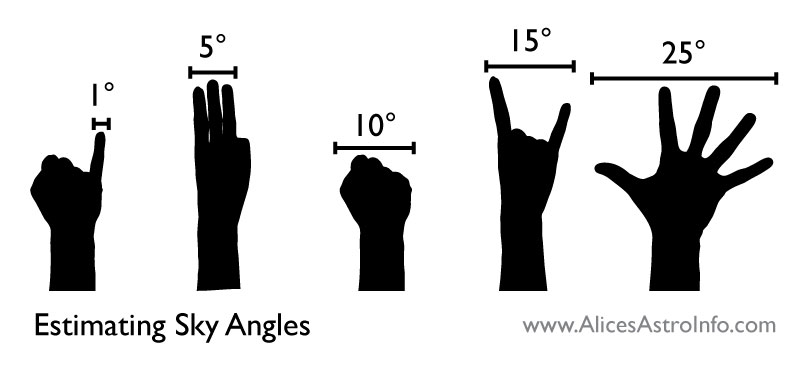
Hold your hand at arms’ length. This works for any size hands assuming you are close to average human proportions, but only if you completely extend your arm.
Actually, this graphic pretty much says it all.
Your fist at arms’ length is about ten degrees wide. Your pinkie finger is one or one and a half.
Know Where You Are and What You Can See
The rest of this article is specific to finding the comet from near Seattle. If you’d like to find it in another location, you’ll need to know exactly where due West is, and the altitude (height) and aziumuth (direction, 270 degrees is due West, and north of West is larger numbers) of the comet for the specific day and time of observation. Try Sky & Telescope for observing data.
Believe it or not, we’ve had good luck seeing this cute little comet from Seattle, between the clouds. You’ll need binoculars.
From the point of Lincoln Park you can easily see Blake Island. It’s the dark one north of Vashon. The South end of Blake Island is at 269°–almost due West (270°). The North end of Blake Island is 15° (the distance of your pointer to your pinkie) towards North, at 284°.
From Alki Point (the one with the lighthouse, not the one with the Statue of Liberty) due West (again, 270°) is the South end of Bainbridge Island.
From the far south side of West Seattle: Arbor Heights, 270° is the North end of Vashon Island.
You can figure this out for yourself pretty quick with a Puget Sound map of your choice. Pinpoint your viewing location and what visible marker on a nearby island or the peninsula is exactly West from you?
Height
To determine how many degrees up into the sky something is, you’re measuring from the perfectly flat horizon. Using the far edge of the water of Puget Sound is a great estimate for this.
Finding the Comet (from Seattle)
Comet becomes visible in binoculars about half an hour after sunset. Forty-five minutes after sunset you might see it with just your eyes.
Monday, March 18, 2013 — Sunset: 7:20pm
- 7:50pm at 280° (one fist North of due West)
13° up (A little less than your pinkie-to-index finger distance).
- 8:25pm at 286° (your pinkie-to-index finger distance North of due West)
7.5° up (between the height of your fist and the height of three fingers)
- 9:00pm at 292° (not quite your full-spread hand North of due West)
2° up (a bit more than your pinkie-width)
Tuesday, March 19, 2013 — Sunset: 7:22pm
- 7:52pm at 282° (between a fist and your pinkie-to-index finger distance North of due West)
13.5° up (A little less than your pinkie-to-index finger distance).
- 8:29pm at 288° (your pinkie-to-index finger distance North of due West)
7.5° up (between the height of your fist and the height of three fingers)
- 9:06pm at 295° (Your full-spread hand North of due West)
2° up (a bit more than your pinkie-width)
Wednesday, March 20, 2013 — Sunset: 7:23pm (Come to the Sunset Watch!)
- 7:53pm at 284.5° (between a fist and your pinkie-to-index finger distance North of due West)
14° up (A little less than your pinkie-to-index finger distance).
- 8:32pm at 291° (Almost your full-spread hand North of due West)
8° up (between the height of your fist and the height of three fingers)
- 9:11pm at 298° (Your full-spread hand plus three fingers North of due West)
2° up (a bit more than your pinkie-width)
Thursday, March 21, 2013 — Sunset: 7:25pm
- 7:55pm at 286.5° (Your pinkie-to-index finger distance North of due West)
14.5° up (Your pinkie-to-index finger distance).
- 8:36pm at 294° (Your full-spread hand North of due West)
8° up (between the height of your fist and the height of three fingers)
- 9:17pm at 301° (Your full-spread hand plus three fingers North of due West)
2° up (a bit more than your pinkie-width)
Friday, March 22, 2013 — Sunset: 7:26pm
- 7:56pm at 289° (Between your pinkie-to-index finger and your full-spread hand distance North of due West)
15° up (Your pinkie-to-index finger distance).
- 8:39pm at 296° (Your full-spread hand North of due West)
8° up (between the height of your fist and the height of three fingers)
- 9:22pm at 304° (Your full-spread hand plus your fist North of due West)
2° up (a bit more than your pinkie-width)
Saturday, March 23, 2013 — Sunset: 7:28pm
- 7:58pm at 291° (Between your pinkie-to-index finger and your full-spread hand distance North of due West)
15° up (Your pinkie-to-index finger distance).
- 8:43pm at 299° (Your full-spread hand plus your fist North of due West)
8° up (between the height of your fist and the height of three fingers)
- 9:27pm at 306.5° (Your full-spread hand plus your pinkie-to-index finger distance North of due West)
2° up (a bit more than your pinkie-width)
Sunday, March 24, 2013 — Sunset: 7:29pm
- 7:59pm at 293° (Your full-spread hand distance North of due West)
15.5° up (Your pinkie-to-index finger distance).
- 8:46pm at 301° (Your full-spread hand plus your fist North of due West)
8.5° up (between the height of your fist and the height of three fingers)
- 9:33pm at 309.5° (Your full-spread hand plus your pinkie-to-index finger distance North of due West)
2° up (a bit more than your pinkie-width)
Basics
I made this graphic for West Seattle Blog. It’ll help you in a general sense, but not on a daily basis.
Want More?
One Minute Astronomer also has a good general write-up about estimating the sky. It is more detailed than mine, more general than mine, and outlines the basics that most amateur astronomers use every night.
I also want to give credit where credit is due. I used hand images, with permission, from all-silhouettes.com. I modified them significantly to suit my purpose. Stanislav makes cool images, but the website is full of links to spam and malware.
![]()
~ A l i c e !
 Photo of Comet PanSTARRS from West Seattle: Through the Clouds
Photo of Comet PanSTARRS from West Seattle: Through the Clouds
I will add more later, but here is the first photo my husband got of Comet PanSTARRS from Lincoln Park here in West Seattle. It was visible between the clouds for about three minutes.
Update, new image!
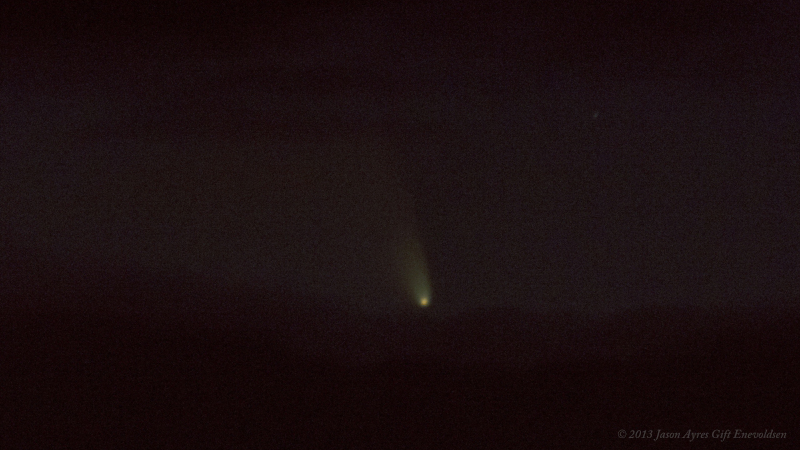
Comet PanSTARRS from West Seattle at 8:32pm on Friday 3/15/2013 (c) my husband Jason Ayres Gift Enevoldsen. E-mail him at jason dot enevoldsen at gmail dot com for reuse permission. Click for bigger. (This is the second, updated image. Below is the first)
This is the original image I posted this evening:
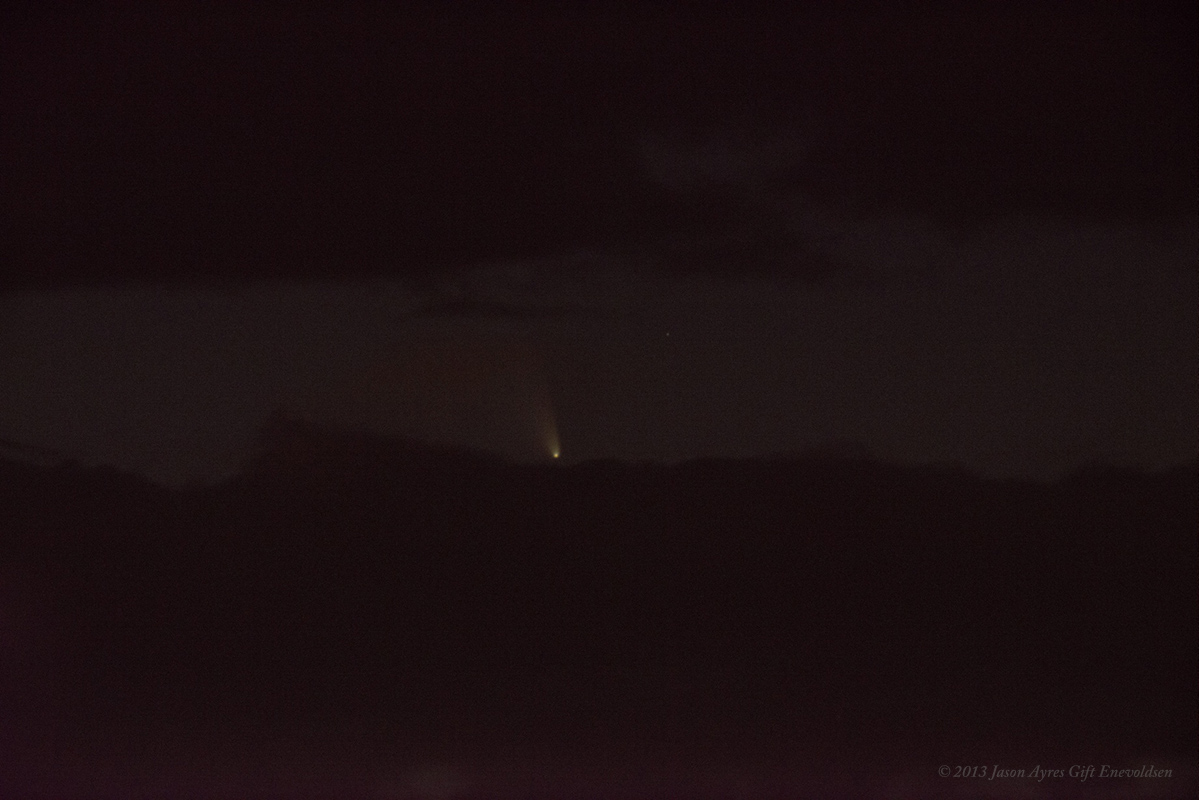
Comet PanSTARRS from West Seattle at 8:32pm on Friday 3/15/2013 (c) my husband Jason Ayres Gift Enevoldsen. E-mail him at jason dot enevoldsen at gmail dot com for reuse permission. Click for bigger
![]()
~ A l i c e !
 Spring Equinox Sunset Watch — 2013
Spring Equinox Sunset Watch — 2013
Is the Sunset Watch going on, even with this weather? Yes.
- In case of pouring rain or lightning storm, this event will be cancelled.
- In case of high wind (non-dangerous), spattering rain, or dense clouds, this event will CONTINUE TO HAPPEN.
Is the Comet Viewing happening tonight? Maybe.
- I’ve been doing nightly comet spotting from the south end of Lincoln Park beach on nights that it are clear enough to see the comet. This is from 7:45pm-8:45pm, now through Sunday the 24th.
- If you look towards the horizon and can see the Olympics, hold your fist out at arm’s length and line up the bottom of your fist with the far edge of the water. If the clouds on the horizon are shorter than your fist, I’ll be there with telescopes to help you find the comet. If the clouds are taller than your fist, they are likely obscuring the comet, and comet-viewing is cancelled for the night.
It’s time for the 16th seasonal sunset watch!!
- When: Wednesday, March 20 at 7:13pm (so come at 7:00pm)
- Actual sunset is supposed to be at 7:23pm, but at the summer solstice we noticed that the Sun set about 10 minutes earlier than the USNO says it does, so I’ve moved the time of our sunset watch up so we don’t miss it. Last autumn the timing seemed to line up correctly – what will it do this time?
- The equinox moment is at 4:02am… but we’re watching the sunset not the sunrise because of how the park lines up.
- Where: Solstice Park – all the way up the hill from the tennis courts (or, if you’re not in Seattle, wherever you have a view of the western horizon!)
- Who: Everyone welcome, as usual.
Come watch the winter solstice sunset at Solstice Park in West Seattle on Saturday the 22nd. We’ll see if the sunset lines up with the placed marker. I’ll be there even if it is cloudy because sometimes the Sun peeks through just as it begins to set, but if it is driving rain or sleet I’m staying home with some hot tea!
If you’re interested – here’s the timing of various celestial events from Seattle, courtesy of the U.S. Naval Observatory Astronomical Applications Department:
Sun and Moon Data for One Day
The following information is provided for Seattle, King County, Washington (longitude W122.3, latitude N47.6):
Wednesday
20 March 2013 Pacific Daylight TimeSUN
Begin civil twilight 6:41 a.m.
Sunrise 7:12 a.m.
Sun transit 1:17 p.m.
Sunset 7:23 p.m.
End civil twilight 7:53 p.m.MOON
Moonrise 11:46 a.m. on preceding day
Moonset 3:19 a.m.
Moonrise 12:41 p.m.
Moon transit 8:22 p.m.
Moonset 3:56 a.m. on following dayPhase of the Moon on 20 March: waxing gibbous with 60% of the Moon’s visible disk illuminated.
This event is my part of the NASA’s Solar System Ambassador program, and thanks to West Seattle Blog for publicizing the last few!
Everyone is welcome, see you there!
![]()
~ A l i c e !

